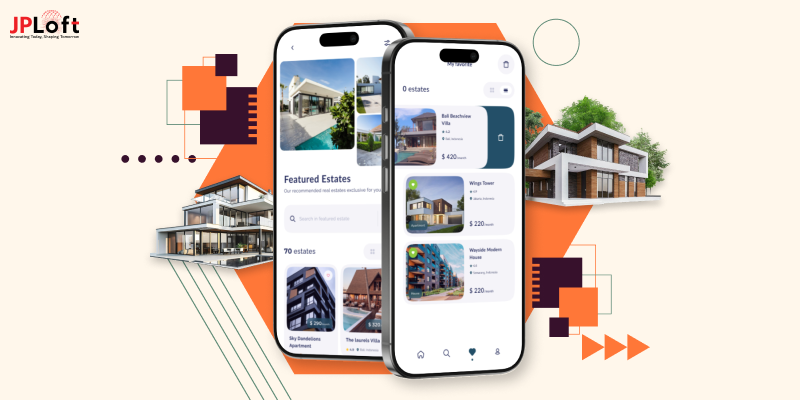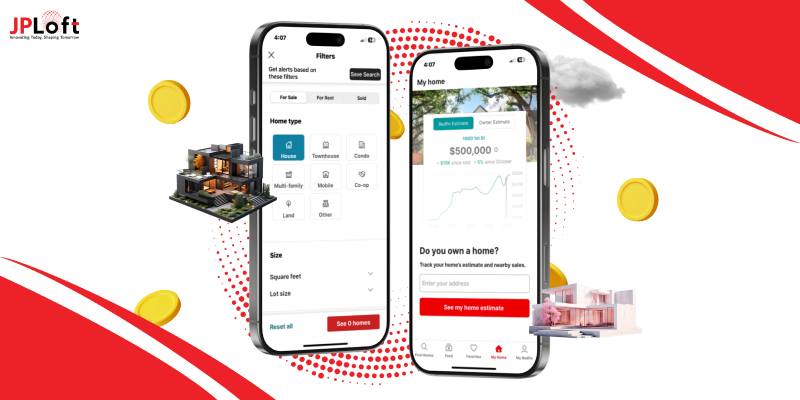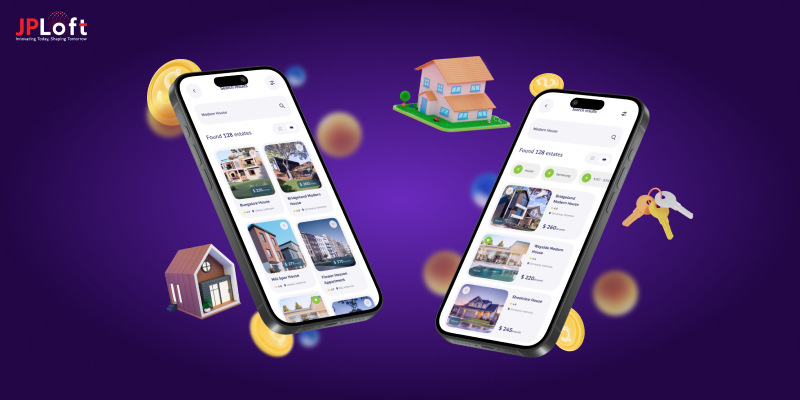Are you thinking to develop a real estate app? That’s great!
Real estate apps are becoming more popular day by day as they help customers to make property buying, selling, and renting so much easier. But creating an app comes with its own set of challenges. While developing a real estate app, you can face hurdles from ensuring a smooth user experience to keeping everything secure.
This blog is going to be the ultimate guide to development challenges of a real estate app. It will also help you to encounter the issues during the app development and how to tackle them.
Development Challenges for a Real Estate App
If you have a strong knowledge of problems, it’ll help you avoid roadblocks while building your app. Let’s take a look at some of the main development challenges in real estate apps so that you can keep things moving smoothly.
1. Inaccurate Property Listings
Suppose a user is looking for a property, and the details are all wrong, like pricing, availability, or even the features of the property don’t match up. Frustrating, right? That’s one of the biggest development challenges in real estate apps.
If your property listings aren’t accurate, it’s going to turn users off and damage your app’s credibility. So, getting those listings right is super important if you want your platform to be trusted.
Solutions:
-
First, make sure your data is always updated by syncing it in real time with property sources.
-
Next, use automated tools to double-check all the property details before they go live.
-
It also helps to team up with trusted real estate agencies or platforms to ensure the data you’re using is accurate.
-
And, don’t forget to encourage users to give feedback if they spot any mistakes. That way, you can fix the issues quickly and keep everything running smoothly.
2. Data Security and Privacy
Now, let's talk about app security and privacy.
Protecting your users' personal information is a big task, especially when it comes to real estate apps. You’ll be handling sensitive stuff like financial details or IDs, and if that data gets exposed, it could be a real problem.
Also, all the security measures can add extra cost to develop an app but it’s worth it. Because it ensures your users feel safe and confident while using your platform.
Not only do you lose your users' trust, but there could also be some serious legal issues. So, making sure your app is secure enough is definitely one of the top development challenges of real estate apps to keep in mind.
Solutions:
-
First, use encryption to protect sensitive information. It’s like putting everything in a safe lock that only you can access.
-
Next, add multi-factor authentication for extra security when users log in. This way, hacking the app wouldn't be easy.
-
It’s also important to update your security protocols regularly. It will help to stay ahead of new threats.
-
And don’t forget about privacy laws like GDPR. This will make sure that your app complies with them to keep your user's data safe and avoid any legal headaches.
3. Real-Time Updates
Making sure everything is up-to-date in real time can be a bit tricky, but it’s a must if you want to keep your app reliable and users happy. Why?
Let us explain.
When you’re dealing with the challenges of a real estate app, it’s super important to show the most updated information, like whether a property is still available, if the price has changed, or any other updates.
If your app doesn’t reflect these changes instantly, it can be disappointing for users. That's why it is one of the major development challenges in real estate apps. Solutions:
-
Use cloud-based solutions to make sure your app delivers data updates instantly. This solution can keep everything synced up in real time.
-
Next, set up push notifications so users get alerts whenever there are changes to a property, like price drops or new availability. It keeps them engaged with the app.
-
Finally, if you want to create an app like Redfin or any other, make sure to integrate your app with proper real time updates.
4. User Interface Complexity
Let’s talk about the complexity of user interfaces for a minute.
When you're building an app, one of the biggest development challenges of real estate apps is making sure it is easy to use and navigate.
If the layout is too complicated or confusing, people will get frustrated and probably stop using it.
Solutions:
-
Keep the design minimalistic and super user-friendly. The simpler, the better! You want users to feel like they can easily navigate without any confusion.
-
Next, make sure you’re doing regular user testing. This way, you get real feedback from authentic users on how easy or hard it is to navigate the app. It’s the best way to make sure everything flows smoothly.
-
Also, don’t forget about clear call-to-action buttons and a consistent layout. You want users to know exactly where to click or tap without second guessing.
-
Your app should look and work great on all devices because everyone expects a seamless experience, whether they’re on a phone or tablet.
5. Scalability
Let’s grab the scalability part.
As your real estate app starts to grow, you’ll need to manage more users, more properties, and more transactions. The challenge is making sure your app can handle all that without slowing down or crashing.
Imagine if you create an app like Willow or any other and it works perfectly with 100 users, but when 1,000 people start using it at once, everything starts to lag or freeze.
That’s where scalability comes in. It’s crucial if you want to keep users happy and your app running smoothly.
Solutions:
-
Start by choosing cloud infrastructure. The cloud makes it super easy to scale your app as your user base and data grow.
-
Next, optimize your app’s code and database for performance. You want everything to run as efficiently as possible, even when traffic increases. It’s all about making your app faster and more responsive.
-
Also, plan for future growth. Using modular development practices helps you build your app in parts, so you can easily add new features or updates without breaking the whole thing.
-
And don’t forget to regularly monitor and analyze your app’s performance.
6. Connect to Third-Party APIs
Okay, let’s talk about connecting your app to third-party APIs which is one of the most important parts to create an app. Most real estate apps need to link up with external services, like payment gateways, mapping tools, or property listing platforms.
It sounds pretty simple, but when you’re working with multiple API sources, it can get tricky.
Different APIs can have different ways of sharing data, update times, or limits on how often you can connect, which can make putting everything together a bit tricky. But if you do it right, it can really boost your app’s features and power.
Solutions:
-
First, try to use reliable, well-documented APIs with good support.
-
It's a smart decision if you want to build custom connectors. This helps streamline the process and makes things more efficient when you’re dealing with multiple APIs.
-
Finally, make sure to regularly monitor API performance and set up backup solutions in case the API experiences downtime.
7. Multi-Platform Compatibility
Let's take a look at multi-platform compatibility. One of the common development challenges of real estate app when building a real estate app is making sure it works smoothly across all platforms, like iOS, Android, and Web.
Each platform has its own set of requirements, and that can lead to inconsistencies in how the app looks or performs. If it does not perform properly, that can frustrate users.
Getting it right means balancing all those differences to give users a seamless experience no matter what device they’re using.
Solutions:
-
Start by using cross-platform frameworks like React Native or Flutter. These tools make it easier to build your app once and deploy it across iOS, Android, and the Web without losing consistency.
-
Next, testing helps you catch compatibility issues early. So, make sure to regularly test your app on different devices.
-
Pay attention to platform-specific UI guidelines too. Each platform has its own design language, so while you want to keep the look consistent, it’s important to adjust it to fit the platform’s style.
-
Lastly, keep everything updated and make sure bug fixes are applied across all platforms. This ensures that no matter where users are, they’re getting the best experience possible.
8. Property Search Filters
Have you ever used an app with a search filter that’s just too complicated to figure out?
It’s boring, right? Well, this is one of the main real estate app development challenge.
If it gets too complex, users will get confused and might just give up. The key is balancing your app with simplicity and functionality. It will help users easily find exactly what they’re looking for without all the hassle.
Solution:
-
When it comes to search filters, keep it simple but effective! Start by focusing on the key property features, like location, price, and property type, because these are what users care about the most.
-
You can integrate advanced search options such as proximity or neighbourhood search. These can help users find the perfect spot.
-
And remember, keep the filter fresh! Regularly update the search options based on what your users are telling you and the data you're collecting. The more relevant the filters, the better the experience.
9. Location Accuracy and Maps
Let’s talk about something super important in real estate apps: location data and maps.
Imagine a user looking for a property and the map shows you the wrong location or takes forever to load. Not fun, right? That’s one of the crucial development challenges for real estate worldwide to get the location data accurate.
If the geolocation is off or the map takes ages to render, users can get frustrated fast. And if your map integration isn’t smooth, it can create a bad experience for anyone trying to find their next home.
Solution:
Let’s break down the solution.
-
To solve location accuracy issues, the first thing you need is a solid map service, like Google Maps or Mapbox. These tools help your users find the right spot quickly and accurately. Just make sure you choose the one that fits your app best.
-
Next, GPS-based location features can really improve search results. By knowing the user's exact location, the app can show more relevant results nearby, like a coffee shop or a property for sale.
-
Also, keep those maps up-to-date because old data can lead to wrong directions or spots that don’t exist anymore. Regular updates ensure users get accurate info.
-
Finally, for those low-coverage areas, don’t panic! Make sure your app still works smoothly offline or in weak signal areas, maybe with preloaded maps, so users don’t get stuck.
10. Mobile Responsiveness
Basically, who isn't sticking to their phone these days?
But imagine your users got your real estate app and it's clunky and slow on mobile. It seems like your app is waving goodbye to user engagement. Thus, mobile responsiveness stands out as a major development challenge of real estate apps.
So, you should make sure that your app doesn't frustrate the users.
To avoid that frustration, it’s important to work with a reliable mobile app development company that ensures smooth functionality and fast loading times and your app keeps users engaged without any lag.
Solution:
-
First off, make sure your design plays nicely with all screen sizes. No matter whether your users are on a phone or tablet, it should look awesome everywhere.
-
Next, let’s talk about speed. Nobody likes waiting forever for an app to load, right? So, make sure it runs fast and smooth, especially for mobile users who are always on the go.
-
And don’t forget to tap into mobile-only features like geolocation. It will help those people searching for properties nearby and users will get a more personal experience.
-
Lastly, the test is the key. Make sure it’s compatible with a bunch of different devices so everyone gets the same smooth experience.
11. High Traffic Load
When someone is searching for a real estate app, it actually means they are searching for their dream home. But high traffic loads can spoil their interest.
That's true, handling high traffic in an app can be a real struggle, especially when a property goes viral or everyone’s browsing during peak hours. If your servers can’t keep up, your users will go back to your app.
Solution:
-
Optimize server performance to support high traffic volumes without compromising speed or reliability.
-
Implement load balancing to distribute traffic evenly across servers, preventing any one server from becoming overloaded.
-
Monitor traffic patterns regularly to anticipate future scaling needs and proactively adjust resources as required.
12. App Performance Optimization
App performance is everything, right?
But it's another challenge while developing a real estate app. Slow loading, laggy interactions, and memory issues are just some of the things that can quickly frustrate users.
Also, the cost to develop a real estate app can increase significantly to ensure app performance but it is a necessary part of a smooth user experience.
Solution:
-
First, compress those images and media files. No one likes waiting for huge files to load, so keep things light and speedy.
-
And here’s a big one. Regularly test your app and make it bug-free. It’s like giving your app a health check-up before it faces any issue.
-
Finally, think of storing frequently used data for quick access, less load on the database, faster speed, and a smoother experience for your users.
13. Payment Gateway Integration
Let’s talk about payments.
Integrating secure and seamless payment gateways is a huge challenge for real estate apps. Most of the time, users are confused about the checkout process and payment gateway.
So, make sure your payment system is not only secure but also super easy to use. Remember, the goal is smooth transactions, so users can focus on finding their dream property, not stressing over how to pay for it.
Solution:
-
You want to make sure your users’ money is in safe hands, right? So, always try to go with trusted gateways that have a solid track record.
-
Also, don’t forget about local currencies and regulations. Make sure your payment methods play nice with the rules in each region, so no one faces any issues with payment.
-
Offer a variety of payment options. Some people prefer credit cards; others might want PayPal or even mobile payments. In this case, you should provide them with options that make their payment easier.
14. Legal Compliance and Regulations
Navigating legal compliance and industry regulations can be a real challenge while developing a real estate app. Ever wonder why real estate laws are so different from place to place?
It's because every region has its own set of rules and you should follow that.
Solution:
- Make sure you’ve got the legal stuff covered, too. Things like disclaimers, terms of use, and privacy policies should be built right into your app. It might not be the most exciting part, but it’s necessary.
-
Partner up with legal pros to make sure everything is fully secure. They’ll help you avoid any legal struggles down the road.
-
And don’t forget about data protection laws like GDPR or CCPA. Making sure your app follows these laws is a must, as it will take much personal data.
Above, we discussed the list of real estate app challenges that you should focus on before developing an app.
Discover How JPLoft Can Help You to Create Real Estate App
So, you’re thinking about creating a real estate app? That’s awesome! Whether you're looking to help people find their dream homes or simply offer a smooth, user-friendly experience, JPLoft, a renowned real estate app development company, is here to make it happen.
From sleek property listings to smart search filters, we make sure your app is simple and intuitive for users to navigate. Our team of professionals is ready to help you every step of the way, from planning and designing to getting that app live for the world to see.
We understand the industry strategy and know exactly how to build an app that helps you connect with clients, enhance your business, and grow in the market.
Excited to bring your real estate app idea to life? It's the right time to enter the market. Partner with JPLoft to make your real estate app stand out in the market.
Final Wrap Up
Now, after reading the entire blog, it is for sure that you understand that creating an app on the real estate platform is not something easy to develop.
In developing an app, challenges are presented at every stage. But proper strategies with little planning will solve all those obstacles and make your app more outstanding.
So, considering all these difficulties, being versatile, and, most importantly, always keeping users' needs at the core during development, one will have a functional application, which also provides the users with seamless, engaging experiences.
Moreover, technology is also constantly changing; thus, always being updated according to trends, continuously improving, and updating one's application helps in moving ahead of others.
The ultimate objective is to deliver a real estate app that users value and trust. With the right approach, your real estate app becomes a game-changer in the market.
FAQs
Some of the most important issues include managing high traffic, legal compliance, smooth user experiences, performance optimization, and handling localization for regions and languages.
For faster speed, you can optimize the size of images, use cloud infrastructure, cache data, and optimize database queries. Testing and debugging will help catch performance bottlenecks early.
Keep track of regional real estate laws, including legal disclaimers when necessary, collaborate with legal professionals, and make sure to be compliant with data protection laws like GDPR or CCPA.
Localization is important because your app will seem relevant and usable to users in different regions, cultures, and languages. User experience and engagement are improved with localization because it caters content to specific needs.
Choose trusted gateways with history, ensure your gateway is ready for local currency, offer numerous payment options that are convenient to use, and implement strong encryption to keep transactional data secured














Share this blog